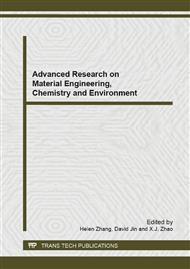p.450
p.456
p.460
p.466
p.471
p.476
p.480
p.486
p.493
A Study on Adsorption Kinetics of Antimony onto Coconut Shell Activated Carbon
Abstract:
The affecting factors and kinetic characteristics of antimony (Sb) adsoption onto a type of the coconut shell activated carbon were investigated in this study. The results showed that: the Sb adsorption obeyed the pseudo-second-order kinetics equation, and the coefficients of determination (R2) were higher than 0.97, inferring that this process was mainly the monolayer chemical adsorption. With the reduction of the particle size, the adsorption capacity of activated carbon gradually increased. With the increase of temperature, activated carbon adsorption of antimony content increased gradually, but on the whole the temperature had a limited effect on the adsorption of activated carbon. Effect of the solution pH on antimony adsorption onto the activated carbon was mainly divided into the following two stages: with a pH value of 1 to 3, antimony removal rate was about 60%, and with a pH value of 5 to 11, the removal rate was about 20%.
Info:
Periodical:
Pages:
471-475
Citation:
Online since:
September 2013
Authors:
Keywords:
Price:
Сopyright:
© 2013 Trans Tech Publications Ltd. All Rights Reserved
Share:
Citation:


